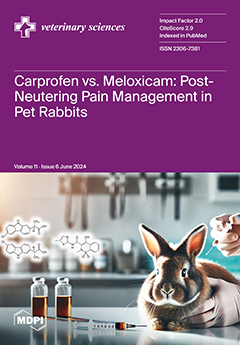Although
Dirofilaria immitis in dogs is considered enzootic in northern Greece, the available data on the occurrence of infection in southern parts of the country demonstrate its scarcity. The aim of this study was to update the current knowledge on
D. immitis infection in dogs in areas of Greece previously considered non-enzootic (Central Greece, Attica, Peloponnese, North Aegean, South Aegean, Crete and the Ionian islands). In total, 1528 dog blood samples were collected from the aforementioned areas and examined by Dirochek
® ELISA (Synbiotics). Additionally, data published until 2022 on the prevalence of infection in these areas were compared to the data of this study. The ‘Wilson’ Score interval method (Epitools) was employed. Overall, 10.8% of dogs were positive for
D. immitis. In detail, the prevalence was 21.7, 13.7, 10.7, 5.4, 4.7, 6.2 and 17.0% for
D. immitis, in Central Greece, Attica, Peloponnese, North Aegean, South Aegean, Crete and the Ionian islands, respectively. Infection with
D. immitis is recorded for the first time in Crete. The probability of a dog becoming infected has increased 4.1 times since 2022 in previously non-enzootic areas. This study denotes the spread of
D. immitis and highlights the necessity for preventive measures.
Full article






